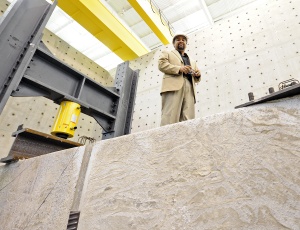Purdue University researchers in West Lafayette, Ind., are working with Westinghouse Electric Co. to ensure that a new design for nuclear power plants will stand up to strong earthquakes.

The work focuses on testing structures like those to be used in the company's AP1000 standard nuclear power plant design. Engineers will test components of an "enhanced shield building" that will contain the plant's main system components.
The building consists of an inner steel-wall containment vessel and an outer radiation shield made using steel-concrete-composite construction. Instead of using conventional reinforced concrete strengthened with steel bars, the steel-concrete-composite approach uses a sandwich of steel plates filled with concrete.
"While this type of construction has been tested and used in Japan, the AP1000 is the first major construction effort using steel-concrete construction in the United States," said Amit Varma, an associate professor of civil engineering who is leading the testing project.
The researchers are concentrating on how seismic forces affect the concrete-filled walls and also the connection between the walls and the structure's reinforced-concrete foundation.
During earthquakes, undulating ground exerts two types of forces on walls: pushing against the edges, or in-plane, and pushing against the sides, or out-of-plane.
Both forces must be studied to make certain the structure is capable of withstanding strong earthquakes, Varma said.
Researchers in the lab will test large specimens by using powerful hydraulic motors, each capable of exerting 1 million pounds of force, and collecting data with sensors embedded in the test pieces.
The largest specimen is a section of wall more than 30 feet long and nearly three feet wide.
The engineers will determine whether the structure is flexible and strong enough to withstand earthquake forces more powerful than federal design requirements, providing a "reserve margin" to ensure radiation is contained.
Westinghouse is funding the work. The project, which began in June, is scheduled to be completed by May. Westinghouse will submit the data to the U.S. Nuclear Regulatory Commission.
The design will be used for several power plants currently scheduled for construction in the United States and China. The NRC reviews and publishes reports on standard plant designs. Several companies have introduced such trademark standard designs.
In other unrelated earthquake research, the National Science Foundation recently announced Purdue will lead a new center, funded with a $105 million NSF grant, called the George E. Brown Jr. Network for Earthquake Engineering Simulation, or NEES.


Post a comment to this article
Report Abusive Comment